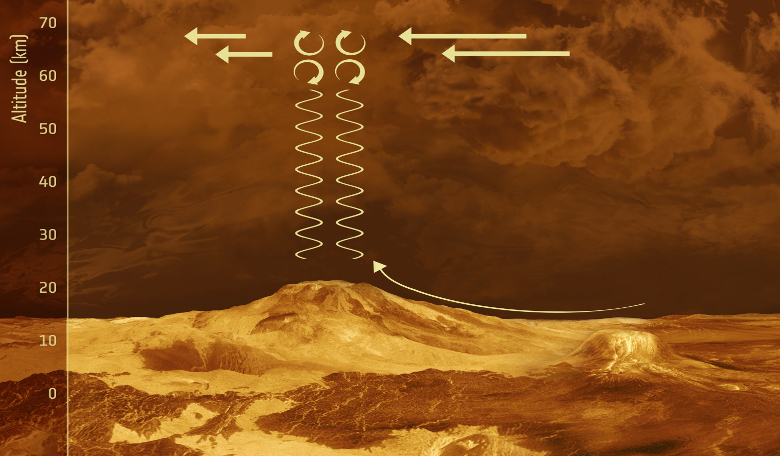The planet Venus is blanketed by high-level clouds, however, rather than acting as a barrier to observations, Venus' clouds may offer insight into the terrain below, as scientists have shown for the first time how weather patterns seen in the thick cloud layers are directly linked to surface features below.
Venus is a world of contrasts. Its surface is incredibly hot due to an extreme greenhouse effect and temperatures can reach as high as 450°C (723.15 K), hot enough to melt lead, while winds in the dense atmosphere blow at painstaking speeds of about 1 metre per second. At the cloud tops, temperatures are a frigid -70°C (203.15 K) – similar to temperatures found at the cloud-tops of Earth – however wind speeds reach 300-400 km/h, much faster than hurricanes on Earth. In addition to being blistering hot, the surface environment is dimly lit, due to a thick blanket of cloud which completely shrouds the planet, making it even less hospitable than already imagined – if such a thing were possible.
Now, using observations from ESA's Venus Express satellite, scientists have greatly improved our climate map of Venus by exploring three aspects of the planet's cloudy weather: how much water is locked up within the clouds, how quickly winds on Venus circulate and how bright these clouds are across the spectrum (specifically in ultraviolet light).
"Our results showed that all of these aspects – the winds, the water content, and the cloud composition – are somehow connected to the properties of Venus' surface itself," says Jean-Loup Bertaux of Laboratoire Atmosphères, Milieux, Observations Spatiales (LATMOS) near Versailles, France, and lead author of the new Venus Express study. "We used observations from Venus Express spanning a period of six years, from 2006 to 2012, which allowed us to study the planet's longer-term weather patterns."
Despite being very dry compared with Earth, some water in the form of vapour can be found in Venus’ atmosphere, particularly beneath its cloud layer and Bertaux and colleagues have been studying the absorption of sunlight by water vapour to detect how much is present in each location at cloud-top level (70 km altitude).
Their analysis has shown that a ‘damp’ region, located near Venus' equator and just above a 4500-metre-altitude mountain range named Aphrodite Terra, is hoarding more water vapour than its surroundings, most likely caused by water-rich air from the lower atmosphere being forced upwards above the mountain tops, leading this phenomena to be nicknamed the 'fountain of Aphrodite'.
"This 'fountain' was locked up within a swirl of clouds that were flowing downstream, moving from east to west across Venus," says co-author Wojciech Markiewicz of the Max-Planck Institute for Solar System Research in Göttingen, Germany. "Our first question was, 'Why?' Why is all this water locked up in this one spot?"
Further studies have found that the winds above the mountainous region are around 18 per cent slower than in surrounding regions, while the clouds downstream of the 'fountain' reflect less ultraviolet light than elsewhere, both of which can be explained by one single mechanism caused by Venus' thick atmosphere suggest Bertaux and colleagues.
"When winds push their way slowly across the mountainous slopes on the surface they generate something known as gravity waves," adds Bertaux. "Despite the name, these have nothing to do with gravitational waves, which are ripples in space-time – instead, gravity waves are an atmospheric phenomenon we often see in mountainous parts of Earth's surface. Crudely speaking, they form when air ripples over bumpy surfaces. The waves then propagate vertically upwards, growing larger and larger in amplitude until they break just below the cloud-top, like sea waves on a shoreline."
Early evidence of atmospheric/gravity waves being generated by air flowing over major topographic features first came to light in 1985 when two Soviet Vega balloons flying above the southern uplands of Aphrodite Terra experienced a bumpy ride. However, scientists have not had a complete picture of how this may work – until now: the breaking waves push back against the fast-moving high-altitude winds slowing them down, however they are then re-accelerated to their usual speeds downstream of the mountainous range causing the motion to act as an air pump. A series of buffering wind patterns creates an upwards motion in Venus' atmosphere that carries ultraviolet-dark material and water-rich air to the surface of the cloud layer, creating both the observed 'fountain' and an extended downwind plume of vapour.
"We've known for decades that Venus' atmosphere contains a mysterious ultraviolet absorber, but we still don't know its identity," says Bertaux. "This finding helps us understand a bit more about it and its behaviour – for example, that it's produced beneath the cloud-tops, and that ultraviolet-dark material is forced upwards through Venus' cloud-tops by wind circulation."
These finding go a long way to not only understanding more about the mysteries that lie beneath Venus’ cloud tops, but also that surface topography can significantly affect atmospheric circulation and how this fits in with current understanding of planetary super-rotation, and of climate in general.
"This certainly challenges our current General Circulation Models," says Håkan Svedhem, ESA Project Scientist for Venus Express. "While our models do acknowledge a connection between topography and climate, they don't usually produce persistent weather patterns connected to topographical surface features. This is the first time that this connection has been shown clearly on Venus – it's a major result."











